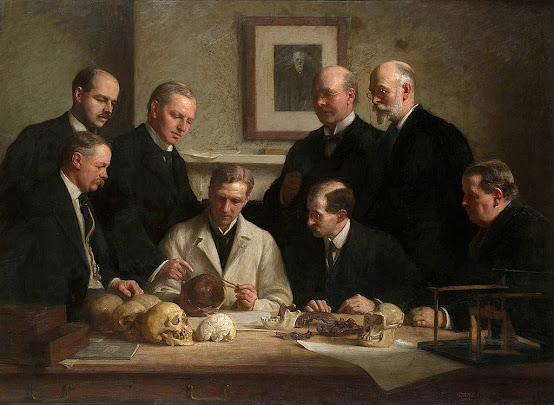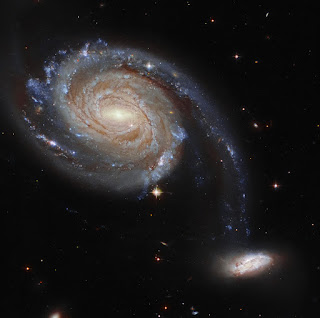The Tragedy of Dark Matter
 |
| Group portrait of the Piltdown skull being examined. Back row (from left): F. O. Barlow, G. Elliot Smith, Charles Dawson, Arthur Smith Woodward. Front row: A. S. Underwood, Arthur Keith, W. P. Pycraft, and Ray Lankester. Note the portrait of Charles Darwin on the wall. Painting by John Cooke, 1915. John Cooke - http://blog.geolsoc.org.uk/2012/12/13/a-tale-of-three-meetings/geological/ |
When the Piltdown Man was discovered to be a complete hoax, it exposed a lot of scientists for being arrogant and ignorant fools. But it is important to realize also that a lot of people were sucked in and had their lives wasted researching nonsense. Some laugh at exposing arrogant and ignorant fools calling themselves scientists, but forget that honest, humble and dedicated scientists got screwed by this hoax. The Pildown man was a fraud in which bone fragments: a human skull of medieval age, a 500-year-old lower jaw of an orangutan and chimpanzee fossil teeth were slapped together and touted as a great discovery of a “missing link” in the evolution of humans. The bones had been deliberately made to look aged by staining them with a solution of iron and chromic acid. The teeth were also filed down to make it look like these human teeth worn from a human diet. The hoax went from 1912 to 1953. The hoax involved a lot more than just the Piltdown man; it was said to have been a life’s work. Charles Dawson was one of the perpetrators of the hoax.
A modern hoax is dark matter. Some of the evidence for its existence is based on ignorance and some of it is based on deliberately falsifying data. However, it stains the reputation of very good astronomers who are giants in their field of study. One such astronomer is Jan Oort, a Dutchman. You may have heard that one of the pieces of evidence for dark matter is that galaxies are spinning too fast and would fly apart if it were not for the existence of the gravitational field of dark matter. Well, it is a paper by Jan Oort from 1928, (“Dynamics of the galactic system in the vicinity of the Sun”, J. F. Oort, Bulletin of the Astronomical Institutes of the Netherlands, Vol. IV), that is the cause of such claims. By the way, galaxies are not spinning so fast they would fly apart. A galaxy consists of about a hundred billion stars all orbiting about a mutual centre of mass. The galaxy is not spinning; it just is made up of stars that are in orbit about a common centre of mass. But let us proceed.
In his paper Oort is calculating the radial velocities of stars he believes are in the neighbourhood of the Sun. It looks like he is including spiral nebulae. Spiral nebulae are outside of the galaxy and have radial velocities of thousands of kilometres per second. Is he including that? In figure 2 of this paper he shows the all velocities of stars to be well under what he estimates as the escape velocity from the galaxy in the region of the Sun, namely 365 km per sec. However, he is also assuming the existence of dark matter. How much dark matter we don’t know. It looks like a little under 3 times the mass of the galaxy. In his presentation of radial velocity of stars he gets values at the most of 56 km per sec. That is certainly not unreasonable and is no where near the escape velocity from the galaxy. The problem with everything he is doing is that he has really no idea of how fast the Sun itself is moving around the galaxy. It looks like he is assuming an orbital velocity of 300 km per sec (figure 1 in his paper). It appears he has also included spiral nebula (distant galaxies). There is nothing in his paper to suggest that our galaxy should be flying apart without the existence of dark matter. And there is no evidence anywhere else by anybody else that galaxies should be flying apart.
When it comes to galactic rotation, or, to be more accurate, the orbital behaviour of stars and material about a common centre of mass, the definitive work was done by George O. Abell, after whom a rather large number of galactic clusters are named. His book, “Exploration of the Universe”, third edition, Holt Reinhart and Winston, is a classic text concerning astronomy overall. Dr. Abell calculated the mass of the Andromeda Galaxy, M31, in chapter 33, to be about 2.5 x 1011 solar masses using Kepler’s third law and Gauss’ Theorem. That’s the usually accepted mass of a galaxy without dark matter. Dr. Abell did not need to imply the existence of exotic non-observable material to calculate the mass of our neighbour galaxy nor to explain the orbital behaviour of outer stars. No one does.
This is also to mention Kepler’s laws of orbital motion and how they were correctly used by Dr. Abell. Kepler’s laws of orbital motion will be gone through in more detail in the future. In this particular investigation, it is the nonsense that galaxies are supposed to be flying apart that is being examined. Maybe someone out there has some data that I have missed. If the orbital behaviour of stars in galaxies is measured, it is seen that stars all go around the galaxy with the same speed. As remarkable as that seems, it is true. Nevertheless, the maximum speed, or tangential velocity, measured in any galaxy is just over 300 kilometres per second. That is well below the escape velocity from a galaxy. Galaxies are not spinning so fast that they would fly apart, in spite of the misunderstanding of circular motion that “flying apart” entails. Jan Oort mentioned some spiral nebula that have a velocity of recession of about 1400 kilometres per second. These objects are not within our galaxy. Maybe that’s where this nonsense comes from.
Each year university students present their work in looking for dark matter. There are some very creative projects. They are all wasting their time. If you do the math, if you examine the original data and look at the assumptions being made, you will find very quickly it is all a scam. It is a terrible waste of human potential. It is a tragedy.

Comments
Post a Comment